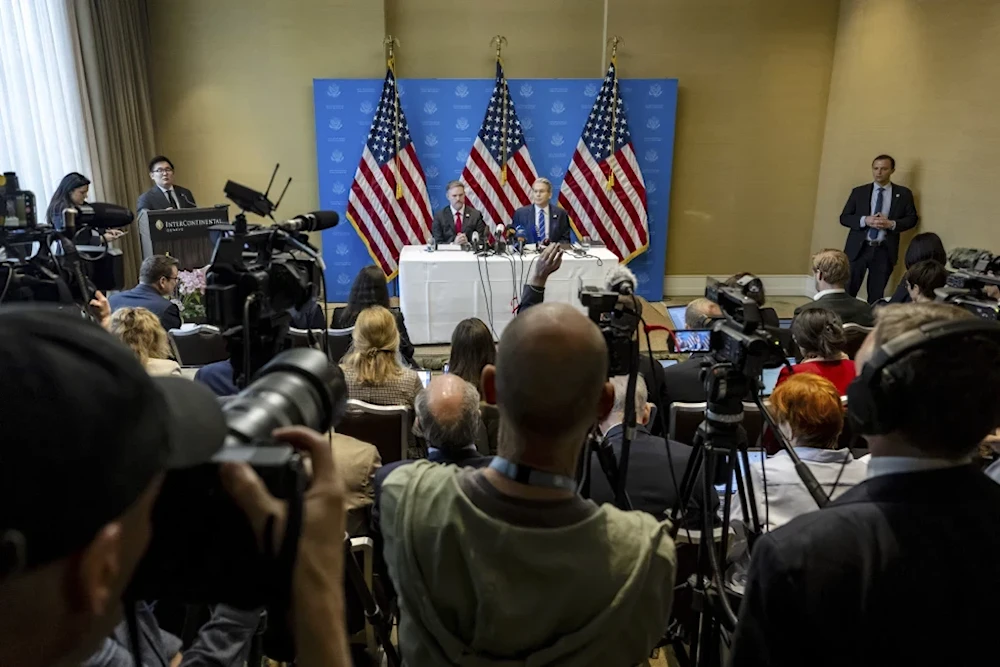China and US tariff cuts in effect after Geneva trade war truce
Washington and Beijing slash tariffs for 90 days after a Geneva deal, easing trade tensions but leaving room for escalation over fentanyl and other issues.
-

US Trade Representative Jamieson Greer, left, and US Secretary of the Treasury Scott Bessent take part in a press conference, Geneva Switzerland, May 12, 2025 (Jean-Christophe Bott/AP)
The United States and China sharply reduced tariffs on each other’s goods for a 90-day period, marking a significant pause in the bruising trade war that has rattled global markets and supply chains.
The temporary deal was reached during high-stakes negotiations over the weekend in Geneva and took effect just after midnight Wednesday, Washington time.
Under the agreement, the US lowered tariffs on Chinese goods to 30%, down from highs that had reached as much as 245%. In response, Beijing cut its tariffs to 10%, more than a 100-point reduction. These concessions mark the first major rollback since tensions escalated under US President Donald Trump, who had imposed sweeping levies as part of an effort to pressure Beijing into economic reform.
Trump’s protectionist trade policy had triggered a wave of retaliatory tariffs from China, bringing total duties on both sides to unprecedented levels. The toll on global equities, manufacturing, and cross-border commerce was immense, prompting renewed efforts to end the impasse.
Speaking to Fox News aboard Air Force One on his way to the Gulf, Trump described the deal as laying the foundation for a “very, very strong” trade agreement, adding that the most exciting aspect was China’s commitment to open its economy to US firms. While light on specifics, Trump framed the breakthrough as a strategic gain for American businesses long shut out of Chinese markets.
“Opening up China” became a central refrain in Trump’s remarks, as he positioned the deal as a turning point in US-China commercial relations. The president’s earlier "Liberation Day" tariff strategy had disrupted international commerce but, according to Trump, helped draw Beijing to the table.
— Donald J. Trump (@realDonaldTrump) April 2, 2025
Meanwhile, China maintained a calmer posture. At a summit in Beijing with Latin American leaders, Chinese President Xi Jinping reiterated that "there are no winners in tariff wars or trade wars," and emphasized the need for global cooperation. Top diplomat Wang Yi added a veiled criticism of Washington, denouncing "major powers" that believe "might makes right."
Lingering disputes and risk of escalation
Despite the breakthrough, several core issues remain unresolved. Notably, Washington's additional 20% tariff linked to complaints about Chinese exports of chemicals used in the production of fentanyl remains in place. The US has long accused Beijing of ignoring the illicit trade, a claim Chinese officials deny. In response, Beijing warned Washington on Tuesday to “stop smearing and shifting blame.”
Analysts caution that the tariff reductions are temporary and that uncertainty will persist as long as the agreement lacks permanence. “Further tariff reductions will be difficult and the risk of renewed escalation persists,” said Yue Su, Principal Economist at the Economist Intelligence Unit.
Trump’s trade war has strained American firms that depend heavily on Chinese manufacturing, while China’s economy has also absorbed significant damage. Both governments appear to be seeking a reprieve, but experts warn that either side could reignite the trade conflict if talks stall.
“Both sides have endured a good deal of economic pain, and they can still endure a little bit more,” said Dylan Loh, assistant professor at Singapore’s Nanyang Technological University, showing the fragile nature of the current truce.

 3 Min Read
3 Min Read








